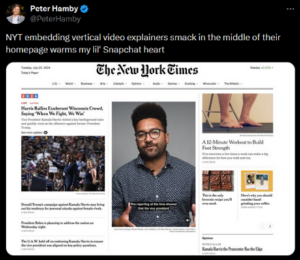What’s behind the resurgence in explainer videos from major publishers?

Explainer videos, explained…
Explainer videos are the equivalent of the ‘For Dummies’ textbook series. So why has that format risen to such prominence, and how are media companies reacting?
The ‘explainer’ has been a popular format since the rise of P2P video. Among the very first videos uploaded to YouTube were ‘How Tos’, though video tutorials were being shared before such video platforms were around.
Since then the format has become a tried-and-true basis for YouTube channels, with everything from travel tips for crossing borders to DIY videos finding a place online.
It has become such a recognised, well-known format that jokes have been made about the way in which they are monetised – and publishers have eagerly jumped on that bandwagon.
In the past few years, however, the priorities of social video platforms have changed. They have prioritised vertical video and short-form content, and the explainer videos have changed to meet those expectations. In turn, that has altered how publishers think about explainer videos – even B2B and information publishers whose content would otherwise not fit that model.
For instance, as Dow Jones has moved from a portfolio-oriented B2B publisher to one that seeks to provide contextually relevant, personalised information to its audiences, it too is looking to revive the short-form explainer.
Emma O’Brian, SVP Strategy for Dow Jones, explained: “It was clear that so much of our audiences, or our desired audiences, were getting news on platforms like Tiktok and Instagram and even other platforms that are not in the same breath.
“So it’s probably no surprise that that very visual audience really needs good news, and needs good journalism. And so the old pivot to video that 10-15 years ago became a joke… I think it’s back in a different way. Maybe it’s dressed up, and we have to be back in vertical video…this has got to be much more dynamic and much more friendly for those different platforms.”

Beyond B2B, news publications are also considering short-form explainer videos for news content. Spurred on, perhaps, by statistics from the Digital News Report and Gallup that demonstrate a large number of young readers get their news from social video platforms, newspapers are also experimenting with the format.
These news explainer videos play into news publishers’ rediscovered mission of providing digests of complicated stories. As with newsletters, they are designed to be one-stop destinations for audiences looking to stay informed.
Speaking at the news:rewired conference in London, representatives of national newspapers explained why they are embracing the format. For example, the Telegraph’s head of video news Kate Chaplin said that its audience increasingly expects to get its news in a variety of video formats. As a result, its team creates video packages that can be repurposed as “20-second homepage clips, then to 5-minute YouTube horizontal videos and then to 60-second vertical videos”.
As ever, however, the devil is in the details. In this case those details relate to the thorny issue of monetisation. Short-form video is tricky to make money from at the best of times given the revenue-share issues with third-party platforms. In addition, individual creators typically outperform publishers on those platforms, making it difficult for publishers to scale viewership to the point it is a major revenue generator.
Some newspapers are attempting to ameliorate that issue by having key reporters become the ‘face’ of their explainer videos. The New York Times’ executive editor Joe Kahn explained: “The difference is that it’s Jonathan Swan, or it’s Maggie Haberman, or it’s Jonah Bromwich. We’re using reporter-on-camera vertical video to offer a kind of explanatory layer to the journalism that we’re doing and to give people a more direct relationship with the beat reporters doing that work.”
At news:rewired, The News Movement’s editor and editorial director Rebecca Hutson said: “the platforms won’t bring us more than pocket money”. However, she also noted that the popularity of the explainer video provides an opportunity for sponsored content deals with commercial partners.
The viability of that model has previously been proved by digital-first publications including Vox. It produced, in partnership with Netflix, 44 episodes of its ‘Explained’ series – taking an episode-length look at a single topic, based on the YouTube series of the same name. During the course of the partnership, its popularity and ‘stickiness’ led to the development of five spin-off series, also for Netflix.
It was a marriage of Vox’s expertise in creating explainer videos and Netflix’s need for sticky content that kept users liable to subscribe.
To that end, newspapers including the Daily Mail are also attempting to leverage their ability to explain topics through long-form video. In June, the Mail launched an in-house studio with the remit to produce a suite of 20 or so shows, which include explainers around health and fitness. Tony Manfred, the Daily Mail‘s global head of video, said:
“As master storytellers and content creators, with a huge breadth of quality content expertise and capabilities, we are incredibly excited about and committed to becoming the world’s most popular video publisher.”
Again, the idea is to capitalise on the popularity of explainer videos – and to retool them to fit a variety of video platforms. That works for the Mail in particular; it reportedly has over 13m followers and one billion monthly views on TikTok.
Video explainers, then, are a tried-and-true format. They cover topics as broad as fitness, DIY, travel, tech… and have proven to be a draw for audiences whether as a one-off or a series. For audience-hungry publishers, the popularity of explainers on video platforms like TikTok and YouTube are also an opportunity for them to reach younger audiences.
Provided that publishers have learned their lessons from the last time there was a major pivot to video, there is an opportunity here for both audience development and revenue growth. And that’s video explainers, explained!
Chris Sutcliffe
Tech and Media Reporter and Co-Founder of Media Voices
enquiries@trippassociates.co.uk
Martin Tripp Associates is a specialist executive search consultancy. We work globally across the media, information, technology, video games and entertainment sectors, and with some of the world’s biggest brands on communications, digital, marketing and technology roles. Feel free to contact us to discuss.